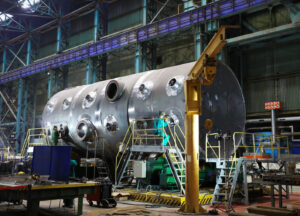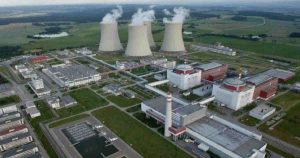The future of home energy sits in Josh and Susan Fried’s Rockville basement near shelves of old tools and canned soup, an unadorned box the size of a wine cooler filled with a dozen silent batteries.
Annoyed by blackouts, the retired dentist and his wife paid $50,000 for the batteries and other technology that could keep their suburban home supercharged. Now, if their cul-de-sac loses power, they can run the air conditioning, the treadmill, even the espresso machine for three days before breaking a sweat.Their power bill is smaller, too, because they can stockpile energy from their solar panels and Pepco’s lines for when the sun isn’t shining or prices are high. When the batteries are fully charged, the couple can even sell some juice back, sometimes making $30 a month.
“The sun is out,” said Josh Fried, 67, one day last week. “I’ve been selling all day.”
The batteries that fuel our cars, laptops and lives have rarely, even in an always-on age, been wired to America’s biggest energy users: our homes. Only a few hundred U.S. homeowners — frustrated by their utility or seeking to go green — have worked with a small corps of battery makers to reduce their reliance on the national grid.
But improving technology, falling prices and backing from electric-car giant Tesla could soon make the battery-powered home cheaper and easier than ever, challenging the long-held utility model of dependence on outside energy — and revolutionizing how America flicks on its lights.
[Report: The way we power our homes may be on the verge of a major change]
Homeowners have used solar panels for years, but the technology has a crippling flaw: They can’t work at night or under cloudy skies. But by storing solar power for anytime use, batteries could help tear down the biggest roadblock to mainstream home-grown energy, especially as the prices for both technologies rapidly decline, according to a report this month from the Rocky Mountain Institute, an influential energy think tank.
But home batteries are already hitting resistance from big utilities, which are now fighting a broad battle with the budding solar industry. And before batteries can secure space in middle-class Americans’ garages and power grid, they will first need to make sense in their budget. The home-battery revolution, experts worry, could prove easily squashed if homeowners aren’t convinced the high-tech safety blankets are worth the cost.
“The technology has always been expensive until very, very recently . . . and even now, homeowners will ask, ‘What am I getting for that price?’” said Haresh Kamath, a program manager for energy storage at the Electric Power Research Institute in Palo Alto, Calif. The battery-powered home could be revelatory, he said, but “we still have to see if any company can pull that off.”
Tesla, the swashbuckling tech firm led by billionaire Elon Musk, is expected to make a high-profile bet on the industry next week when it unveils its own home battery, based on the same type of rechargeable lithium-ion brick found in most modern laptops and phones.
As with the few batteries now on the market, Tesla’s would gulp down power, guard against blackouts and replace noisy and dangerous gas generators. But the Tesla battery’s real potential strength, say analysts who have seen early models, would be in its everyman simplicity: The size of a kitchen cabinet, it makes no noise, needs no maintenance and can be installed in an afternoon.
Tesla has in the last two years quietly installed batteries in a few hundred test households across California, said Trip Chowdhry, an analyst at Global Equities Research. He expects the batteries will cost between $10,000 and $15,000, but be offered on 20-year leases with payments as low as $1,500 down and $15 a month.
“The main use case, it’s not the die-hard environmentalists,” said Chowdhry, who added he expects 10 million American households will show interest. “The guy who leaves his iPhone at home and for the whole day he feels incomplete, that’s the target audience.”
Tesla did not respond to requests for comment, but the company emailed investors and analysts this week to say the company would introduce the Tesla home battery, plus a “very large utility-scale” battery, at an April 30 unveiling event.
“We will explain the advantages of our solutions,” Tesla chief of investor relations Jeff Evanson wrote, “and why past battery options were not compelling (okay, Elon said ‘sucked’).”
Batteries already help power homes in places where energy grids are spotty, on islands and in developing countries including India and Bangladesh. But they have remained a niche for homeowners in the U.S., even as more and more demanding connections on America’s aging power grid have pushed power outages up 285 percent since 1984.
Tesla, with its corporate star power, has quickly become the home-battery industry’s best-known cheerleader, and its boosterism could give home batteries their best shot at finding acceptance in mainstream America.
The electric giant already boasts a unique head start. Tesla is now building the world’s largest battery factory, a $5 billion “gigafactory” in the Nevada desert, that it says will drive the prices of batteries usable in homes and cars down by more than 30 percent.
A few companies are already switching on Tesla-brand battery power. SolarCity, the solar-panel installer for which Musk serves as chairman, has installed Tesla batteries at 13 Wal-Mart superstores in California “to help manage peak energy demand,” and will likely add more in the coming years, Wal-Mart spokesman Kevin Gardner said.
Chowdhry said Tesla batteries have also been installed in Google offices, and are in the blueprints for Apple’s sprawling new campus, though neither company would confirm those plans.
Even with Tesla’s backing, home batteries will remain a shrimp compared to America’s juggernaut of a power grid. With its nearly 3 million miles of transformers and power lines, it has been described by some as the biggest machine on earth.
But traditional utilities are still concerned about how the “distributed energy” of home batteries and renewable energy could cripple their bottom line by allowing homeowners to create or store energy without paying toward the grid’s wildly expensive maintenance costs.
The utility industry’s trade group, the Edison Electric Institute, has said that batteries are among the very real “disruptive threats” that could allow ratepayers to slim their addiction to power lines.
“To put this into perspective,” the group said in a 2013 report, “who would have believed 10 years ago that traditional wire line telephone customers could economically ‘cut the cord?’ ”
Sales of combined solar-battery systems are expected to bloom to $1 billion a year by 2018, GTM Research analysts said. Meanwhile, their prices will continue to fall: The Rocky Mountain Institute report said the systems would be affordable for homeowners in communities from the New York suburbs to Los Angeles within a decade.
But not everyone is convinced Americans will buy into storing rivers of electrons in their garage. A potential market for home batteries is further down the road than Tesla expects, wrote Bank of America Merrill Lynch analyst John Lovallo in a note to investors last month, adding that the home-battery system’s success was a “long-shot at best.”
The batteries could lose some luster if utilities crack down or charge extra for “net metering,” in which homes sell energy back to the grid. The grid itself, with its relatively reliable energy, will also make it easy for the batteries’ target homeowners to stay away.
“Competing with the grid is tough,” said Peter Lilienthal, the chief executive of HOMER Energy, which provides software and consulting for self-sustained energy microgrids. “It comes down to: What’s the value of reliability? Everybody’s going to have their own price.”
For the Frieds, who moved from Poughkeepsie, N.Y., to Maryland to be closer to their grandchildren, all it took was a chain of annoying blackouts to convince them it was worth the cost. The couple called a local solar-panel contractor, who installed 12 OutBack Power batteries designed for back-up electricity.
Though theirs is the only home for miles, that they know of, powered by a battery, the trend away from the grid seems to be catching on. Recently, their neighborhood held a “going solar” meeting at the local community center.
It will take years, if ever, for them to make their money back in energy savings, but the couple is, as Susan Fried said, happy to have made “our teeny-weeny contribution to being environmentally conscious.”
One sun-drenched morning recently, while piloting his Tesla Model S past the white picket fences of his pleasant Maryland suburb, Josh Fried dreamed aloud about the blackout that would finally make the couple’s big investment pay off.
“Everyone in the neighborhood is going to say, ‘Can I come plug my phone in?’ ” he said with a laugh. The only problem, he added, if it counts as one: His neighborhood hasn’t lost power in months. – EIN News




